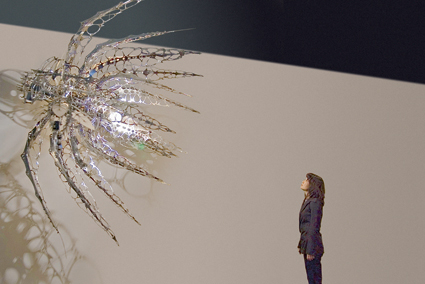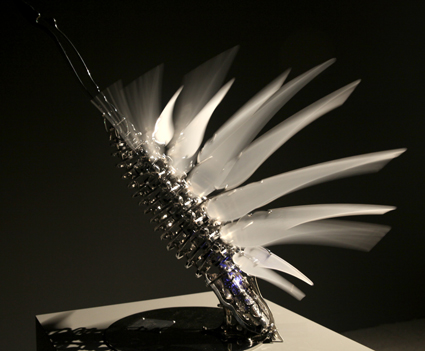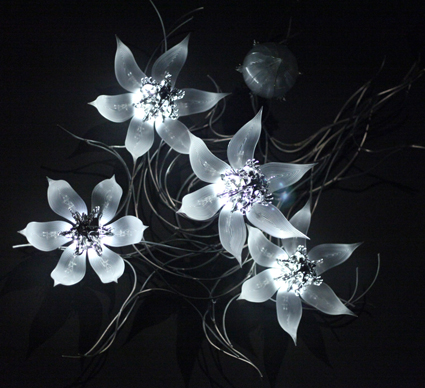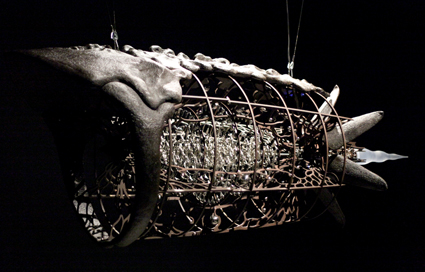living with biomorphic anima-machines
christina chau: u-ram choe

U-Ram Choe, Urbanus Female, 2006, installation view, Mori Art Museum, Tokyo
GAMBLING ON A SMALLER VISUAL ARTS PROGRAM BUT WITH HIGHLY COMMENDED NATIONAL AND INTERNATIONAL ARTISTS IN THE PERTH INTERNATIONAL ARTS FESTIVAL HAS CERTAINLY PAID OFF THIS YEAR WITH RECORD BREAKING ATTENDANCES AT SOUTH KOREAN ARTIST U-RAM CHOE’S SOLO EXHIBITION. CHOE’S DELICATE AND HIGHLY TECHNICAL KINETIC SCULPTURES WERE ELEGANTLY INSTALLED AMIDST DARKNESS, HOVERING UNDER ILLUMINATED LIGHT WITHIN THE CORNERS AND CORRIDORS OF THE JOHN CURTIN ART GALLERY.
Featuring nine machinic organisms accompanied by plaques that describe their behaviours, habitats and adaptive responses, the exhibition forms Choe’s premonition of how machine life will evolve in a future technocratic society. It is a world populated by these life forms (or anima-machines) that have adapted faster than humans and thrive in urban environments. They have been ornately designed to resemble natural flora and fauna but have adapted by acquiring light steel skins for protection and factory motors instead of organs. They graze on residual urban energy, airborne viruses and unclaimed data and live in harmony with their environment. Choe invites his audience to study this realm, the behaviours of these specimens, to become accustomed to their nature and understand that these creatures are an harmonic synthesis of technological systems and the natural order.
Each of the eight machine organisms is a delicate hybrid of mechanical engineering and nature. Each form, movement and behaviour has been designed specifically for these organisms to not only exist but also thrive in their machinic environments. Instead of proposing a threat to humanity they harmoniously perpetuate the life and energy cycles of machinery.

U-Ram Choe, Nox Pennatus, 2005, installation view, John Curtin Gallery
Some works are in constant repetitive motion, while others wait to sense human presence before performing their gestures. Each work has been intricately designed and fastidiously engineered to not only mimic the complexity of the natural order but to demonstrate a capacity for the visceral elegance in machinic movement. The skeletal creations are fitted with perforated steel skins to expose the entire operation of hundreds of custom-made steel ligaments, joints, frames, CPU and LED motors. The connection of each component meeting and moving with the next forms an orchestration that reveals mechanical bodies to be as detailed as our own in motion.
The centerpiece of the exhibition, Urbanus Female (scientific name: Anmopista Volaticus floris Uram) (2006) is a flower-like anima-machine that Choe has created as a nocturnal feeder of urban energy. In the gallery it lies dormant, suspended from the ceiling until it senses human presence, which cues the work to perform its anthesis [the period during which a flower becomes fully open and functional. Ed]. With each turn, the flower—its stamen a twisting and beaming metal halide lamp—opens and closes slightly before unfolding entirely, expanding three metres in diameter and reaching forward to the viewer.

U-Ram Choe, Una Lumina, 2005, installation view, John Curtin Gallery
Choe has designed the interaction between his Urbanus Female and those in its company as an elusive form of communication. Its gestures require our patience, its grand unfolding taking place at its own rate. Choe’s great trick reminds us that we are in the gallery to study, rather than command the behaviour of these rare specimens for our entertainment. We are in their space, in their world as their audience.
Around a corner stands Ultima Mudfox (2002), hovering with its fins waving in perpetual motion but otherwise still for us to examine its delicate skeletal structure. After reading their accompanying narrative we find that these creatures “free themselves, one after another, from the factory that created them, clone themselves in a base camp beneath the city, where electromagnetic waves are abundant” (Choe, U-Ram, Exhibition Catalogue, 2012). The artist clearly pursues the issue of sustainability between humans and machines. When set into motion and given life, anima-machines live, breed, consume and expire alongside humanity, feeding off computer viruses and unclaimed data and converting them into resources. Choe envisions a world where these creatures subsist within the cycles of human life and production as independent and complementary beings.

U-Ram Choe, Jet Hiatus, 2005, installation view, John Curtin Gallery
It is common for kinetic artists to explore technology’s capacity to either assail or assist humanity. At times these tropes can perpetuate a reductive dichotomy between nature and technology. Choe successfully avoids this binary association by presenting his works as fantastical beings that thrive in the technocratic society from which they are born. U-Ram Choe firmly believes that the evolutionary capacity of machines is far more advanced than our own and that we can therefore learn from our technological creations. His art is an invitation to study their advanced behaviour and adaptive responses, approaching these anima-machines as our future companions and providers.
2012 Perth Festival, U-Ram Choe, John Curtin Art Gallery, Perth, Feb 3-March 4
See a short video interview with U-Ram Choe on the Creators Project
RealTime issue #108 April-May 2012 pg. 4






